Volume 19 Issue 2
Latest articles
- Researchpp 2106-2119Abdelhady, M. A., Abdelghany, T. M., Mohamed, S. H., and Abdelbary, S. A. (2024). “Impact of green synthesized zinc oxide nanoparticles for treating dry rot in potato tubers,” BioResources 19(2), 2106-2119.AbstractArticlePDF
Potato (Solanum tuberosum) crops have experienced a 22% reduction due to attacks from microbial pathogens and pests. Dry rot disease occurred from risks in El-Minya governorate, Egypt, where potato is the major cultivated crop. Potato cultivar ‘Cara’ samples were collected from the markets of six regions in El-Minya for isolation. They were also tested for the application of biosynthesized zinc oxide nanoparticles (ZnONPs) for disease management. The ability of Exserohilum rostratum to synthesize ZnONPs was documented via UV-visible, X-ray diffraction, Fourier transform infrared spectrum, and transmission and scanning electron microscopy. Spherical shape and crystallite small size (51.0 ± 3.0 nm) were attributed to the created ZnONPs. The ZnONPs were applied in the bio-control of the causative agent (Fusarium nygamai) of dry rot disease and large economic loss of potato cv. ‘Cara’ productivity. The mycosynthesized ZnONPs by E. rostratum at 100 μg/ mL (3 mM) showed antifungal activity against F. nygamai with higher reducing value of mycelium growth diameter 2.0 ± 0.14 cm compared to Revanol 50%, traditional product with a diameter of 3.85 ± 0.10 cm. Overall, ZnONPs are an excellent agent that can be applied to repress the most common fungal disease of potato.
- Researchpp 2120-2134Safwa, M., Yeddu, H. K., and Leminen, V. (2024). “Modeling of the thermoforming process of paperboard composites for packaging,” BioResources 19(2), 2120-2134.AbstractArticlePDF
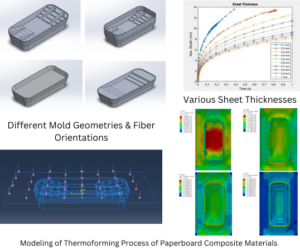
The quest to reduce global plastic consumption has led to the emergence of biodegradable fiber-based composites as a promising sustainable replacement to conventional plastics in the food packaging industry. As the packaging sector is shifting more towards fiber-centric materials, thermoforming techniques for the 3D forming of the fiber-based materials, especially using complex mold designs, should be thoroughly researched to replace the conventional plastics in the industry. Finite element analysis of the deformation behavior of the paperboard during the thermoforming process and the factors that trigger the fracture of the composite layers were studied in the present work. The results show that 90° fiber orientation, 0.3 mm sheet thicknesses, and specific mold geometries can result in better forming results, thereby maximizing the potential of fiber-based materials in thermoforming.
- Researchpp 2135-2148Özel, H. B., Şevik, H., Yıldız, Y., and Çobanoğlu, H. (2024). “Effects of silver nanoparticles on germination and seedling characteristics of Oriental beech (Fagus orientalis) seeds,” BioResources 19(2), 2135-2148.AbstractArticlePDF
Nowadays, the applications of nanotechnology are increasing in various fields such as information technology, energy, the medical sector, and agriculture. Nanotechnology has proved its ability to solve problems in agriculture and related industries. Establishing the impact of nanoparticles on various ecosystems has become a primary research topic, but studies on forest ecosystems and trees are quite limited. This study examined the effects of silver nanoparticles on the germination parameters of oriental beech seeds and established their toxic threshold values. Silver nanoparticles were applied at concentrations of 200, 400, 600, 800, and 1000 mg/L to oriental beech (Fagus orientalis) seeds collected from 10 different populations in order to identify the germination rate, germination percentage, seedling height, root collar diameter, plumula length, radicle thickness, and radicle length parameters. The results revealed that silver nanoparticles have a negative effect on germination and seedling parameters of oriental beech seeds, and that this effect is clearly seen in the germination rate at 20 mg/L levels and in seedling characters starting from 60 mg/L dose, causing a decrease of 13% in germination rate, 24% in germination percentage, 40% in plumula length, and 30% in radicle length. The Kahramanmaras-Andirin population was found to be the most affected by nanoparticles, while the Bursa-Inegol and Ordu-Akkus populations were the least affected.
- Researchpp 2149-2159Zhang, M., Tang, X., Si, T., Wang, X., and Wu, X. (2024). “Preparation of antibacterial and strong regenerated cellulose film via crosslinking with polymeric quaternary ammonium salt containing epoxy/ZnO,” BioResources 19(2), 2149-2159.AbstractArticlePDF
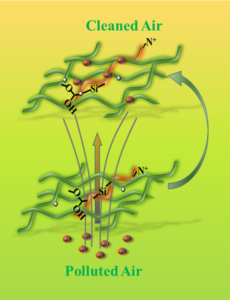
Particulate matter (PM), usually formed as aerosols suspended in atmosphere, is becoming a carrier of viruses and bacteria, accelerating the spread of respiratory diseases. Hence, air filtration devices are widely utilized for removing PM. In this study, a regenerated cellulose (RC) film was prepared with the properties of good mechanical strength, antibacterial, and highly efficient filtration (EF) properties, through cellulose dissolution and further crosslinking with P(AGE-DMDAAC)/ZnO. Results exhibited that the Young’s modulus of the composite membrane was nearly 4.3 GPa. Additionally, the antibacterial performance against Escherichia coli and Staphylococcus aureus, was up to 99.89% and 99.67%, respectively. Meanwhile, RC composite filter exhibited a high PM 2.5 capture efficiency (over 99.91%). This study introduces an interesting approach to produce antibacterial films with the characteristics of notably good mechanical performance and high fine particle EF that can be utilized in a high humidity environment.
- Researchpp 2160-2178Yilmaz, B., Deniz, İ., Fazli, H., Bekircan, O., Pranovich, A., and Karaoğul, E. (2024). “Sustainable thermoplastic road marking paint production from natural modified rosins,” BioResources 19(2), 2160-2178.AbstractArticlePDF
Modified natural rosins were evaluated as binders in the production of thermoplastic road marking paints (TRMPs). Pine rosin (GR), wood rosin (WR), and tall oil rosin (TOR) were used. Fourier transform infrared spectroscopy (FT-IR), thermogravimetric analysis (TGA), matrix-assisted laser desorption/ionization (MALDI-ToF-MS), and gel permeation chromatography-high pressure liquid chromatography (GPC-HPLC) were performed on natural and modified rosins. Acid number (mg KOH/g) ASTM D 465 – 05 and softening point, (°C) ASTM E 28 – 99 standard tests were applied to the samples. For the optimum synthesis condition, the pentaerythritol/rosin mol/mol ratio is 1/1, with the levels of Irganox 1425/rosin w/w, 0.5%, and TBM-6/rosin w/w, 1.0%. Gel permeation chromatography-high pressure analysis revealed that the esterification reaction yield was over 90% for each of the three natural rosins. Moreover, chromaticity coordinates (x,y), gloss factor (β), softening point (°C), and UVB aging test were applied to TRMPs. Modified natural rosins showed better results in the production of TRMPs. This is an important development and crucial step for sustainable TRMP production.
- Researchpp 2179-2200Alrowais, R., Abdel daiem, M. M., Helmi, A. M., Nasef, B. M., Hari, A. R., Saikaly, P., and Said, N. (2024). “Effect of alkaline pretreatment on the characteristics of barley straw and modeling of methane production via codigestion of pretreated straw with sewage sludge,” BioResources 19(2), 2179-2200.AbstractArticlePDF
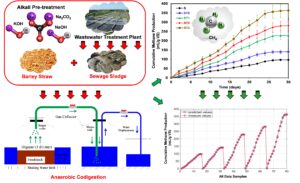
Straw pretreatment enhances the cellulose accessibility and increases the methane yield from anaerobic digestion. This study investigated the effects of alkali pretreatments with different chemical agents (NaOH, KOH, and Na2CO3) on the physicochemical and thermal characteristics of barley straw, as well as methane production from codigestion with sewage sludge. Artificial neural network modeling with a feedforward neural network (FFNN) and slime mold optimization (SMO) techniques were used to predict methane production. NaOH pretreatment was shown to be the best pretreatment for removing hemicellulose and lignin and for increasing the cellulose accessibility. Moreover, there was a 2.57-fold higher level of methane production compared to that from codigestion with untreated straw. The removal ratios for the total solids, volatile solids, and chemical oxygen demand reached 59.3, 67.2, and 73.4%, respectively. The modeling results showed that the FFNN-SMO method can be an effective tool for simulating the methane generation process, since training, validating, and testing produced very high correlation coefficients. The FFNN-SMO accurately predicted the amount of methane produced, with an R2 of 0.998 and a 3.1×10-5 root mean square error (RMSE).
- Researchpp 2201-2215Zhang, Z., Li, Z., Yao, L., Chang, S., and Wu, Y. (2024). “Development and performance evaluation of sunflower straw cellulose ether ecological sand-fixing material,” BioResources 19(2), 2201-2215.AbstractArticlePDF
Sunflowers are widely cultivated as a cash crop in the Inner Mongolia Autonomous Region, China. However, due to the lack of efficient resource utilization techniques, most of the sunflower stalks are discarded. In the Hetao irrigation area, the problem of desertification has prompted the limited use of sunflower straw to construct physical sand barriers for windbreaks and sand stabilization. In response to this, this study focuses on synthesizing a cellulose ether sand-fixing material using sunflower straw, the primary agricultural waste in Denkou County, Hetao irrigation district. This material enhances the effective adhesion between sand grains, reduces porosity among loose sand grains, and inhibits sand grain movement. The findings from this study conclusively demonstrate that the sand-fixing materials under investigation meet international standards for mechanical properties. They effectively transform loose, unconnected sand grains into a state with strong adhesion properties.
- Researchpp 2216-2243Han, C., Zhu,X., Chen, K., Wang, X., Leng, F., Wang, Y., and Li, S. (2024). “Comparative production performance and rumen bacterial diversity of fattening beef cattle supplemented with different levels concentrated feed,” BioResources 19(2), 2216-2243.AbstractArticlePDF
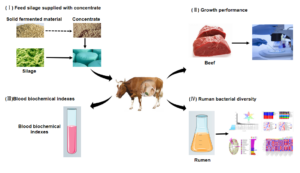
The production performance and rumen bacterial diversity were compared for different silage-based diets supplemented with common concentrate or bio-concentrate to develop an alternative of common concentrate for fatten cattle feeding. The daily gain of fattening cattle was increased by 0. 99 kg and 1.04 kg, respectively, when fed with single corn silage or mixed silage-based diet supplemented with bio-concentrate. There was no significant difference in water loss rate and cooked meat rate among groups (P>0.05), but the tenderness of beef in the bio-concentrate group was significantly higher than that in the common concentrate group (P<0.05). There were no adverse effects on beef quality and blood biochemical indexes in each group. Compared with the normal concentrate group, the OTU number and α-diversity index of rumen microorganisms of fattening cattle fed with mixed silage as the basic diet supplemented with bio-concentrate increased significantly. At generic level, the relative abundances of Prevotella, Porphyromonadaceae (unclassified), and Succiniclasticum were increased by adding bio-concentrate in the diets based on mixed silage and single sorghum silage. Relative abundances of Bacteroidetes (unclassified), Ruminococcaceae (unclassified), and Firmicutes (unclassified) decreased. In conclusion, the bio-concentrate might be a better choice than common concentrate for beef cattle breeding.
- Researchpp 2244-2271Zhand, S., Yang, B. S., Kang, K-Y., and Jeong, M. J. (2024). “Robust pretreatment in combination with ultrasound-assisted surfactant to improve the enzymatic hydrolysis of Eucalyptus pellita,” BioResources 19(2), 2244-2271.AbstractArticlePDF

Alkaline pretreatment stands out as a valuable strategy in biomass conversion to overcome the recalcitrance of biomass by removing lignin and a part of hemicellulose. This enhances enzyme accessibility and promotes saccharification. However, increasing the alkaline concentration to enhance the delignification and improve glucose yield together presents inherent limitations. In this experiment the amount of delignification and glucose yield resulting from surfactant associated with sonication during mild alkaline pretreatment of Eucalyptus pellita was investigated. Also, the effect of various factors (sonication temperature and surfactant immersion time) on delignification and glucose yield were examined. The results demonstrated that surfactant associated with sonication pretreatment could overcome the limitation of alkaline pretreatment and could increase the amount of delignification alongside enzymatic hydrolysis glucose yield of Eucalyptus pellita wood by around 90%. The findings indicated that surfactant-assisted with sonication during mild alkaline pretreatment of Eucalyptus pellita (i.e., hardwood) could be recommended as a supporting pretreatment method for the production of monomeric sugars.
- Researchpp 2272-2285Berthold, L., Niini, A., Tanninen, P., Leminen, V., and Majschak, J.-P. (2024). “Role of blank moisturisation in press forming of paperboard,” BioResources 19(2), 2272-2285.AbstractArticlePDF
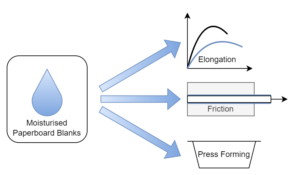
To investigate the influence of blank moisture on the forming of paperboard, press forming experiments were performed with fixed blank setup and sliding blank setup to produce paperboard trays. The trays were rated by their forming height. Different moisturisation procedures were established to achieve one or double-sided surface moisturisation or homogenous moisture distributions in the blanks. Additionally, basic influences of moisture to paper-to-metal friction and tensile properties of the paperboard were measured. Surface moisturisation increased the paper-to metal friction and therefore limited the achievable forming heights in sliding blank press forming. The elongation at break of paperboard increased with increased sample moisture content. In the fixed blank press forming test this increase was not apparent in the data.
